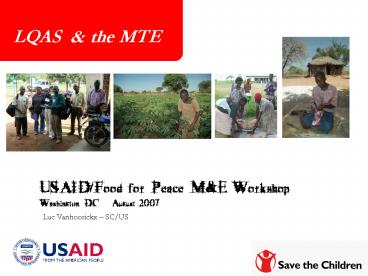LQAS - PowerPoint PPT Presentation
1 / 18
Title: LQAS
1
LQAS the MTE
Luc Vanhoorickx SC/US
2
Presentation overview
- Introduction Uganda DAP
- Key concepts LQAS dichotomic, 19 and the Lots
- Application of LQAS Uganda DAP
- Lessons Learned
3
EFSPA Program Background
Enhancing Food Security through Poverty
Alleviation
- A 5 yr FY04-FY08 DAP funded by USAID FFP Title-II
PL480 - 3,840 subsistence farming households, 2,500
HIV/AIDS affected households, and 9,774
malnourished children under 3 years of age - LOA budget 9.85M
- Partnerships District, ACF, etc
4
EFSPA Strategies
- Borehole rehabilitation, Latrine building,
WSSCs, - Support MOH EPI outreaches, IMCI activities,...
- BCC campaign, PDQ, Mother groups trainings
- GMP, food aid,
- Support AEW, Model Homesteads, Trainings,
- Establish market information systems, FFW,
- Assist Livelihood Support Groups, Mentor
youth,... - Build capacity of district staff,
5
Results FrameworksWhere is results monitoring?
Goal
RESULTS MONITORING
Strategic Objective
Check change in knowledge, behavior, status
IR 1
IR 2
IR 3
IR 4
Strategies
Activities
6
Monitoring Evaluation gt LQAS
Higher level monitoring, e.g. before DAPs MTE in
Haiti, Uganda
? Measure outcome/ impact indicators from IPTT
compare w/ baseline final targets
From the Monitoring we knew that we were
generally carrying out the activities as planned,
but wanted to MonitorEvaluate whether it all had
the desired effect/result/outcome/impact
? Effects of BCC campaign
Health/Nutrition behaviors Agricultural
techniques
gt information needed population/beneficiary
based gt sampling needed !
LQAS Lot Quality Assurance Sampling
- determination of the quality of a lot by
sampling
Lot supervision area, district, etc
? small sample size, typically 19 per area
? comparison between areas (lots) possible
7
LQAS dichotomic - 19
Lot Quality Assurance Sampling
- in general small (19) RANDOM sample for
acceptable precision of at least 92 on
dichotomic conclusions
For example, what LQAS can just by sampling 19
farmers or mothers in a targeted population,
LQAS will determine correctly whether yes or no
the targeted farmers have adopted the soil
preparation techniques, or whether a certain
target coverage of exclusive breastfeeding is
reached in a beneficiary population
For example, what LQAS can just by sampling 19
farmers or mothers in a targeted population, at
least 92 of the time LQAS will determine
correctly whether yes or no the targeted farmers
have adopted the soil preparation techniques, or
whether a certain target coverage of exclusive
breastfeeding is reached in a beneficiary
population
? LQAS cannot be used for coverage estimates in
lot!
? Only if its above/below target ? Decision
Rule
8
LQAS dichotomic ? decision rules
- Decision Rule determined with LQAS chart
- Top row to find coverage/target, rounded up to
next highest 5 increment - Horizontal row for the sample size (generally
19) - Where the column and row cross, its the
Decision Rule
11
9
LQAS lots average coverage
- the small sample is a motivation! But also
? comparison between areas (lots) desirable gt
LQAS
Use LQAS to check which areas reach targets or
have high coverage ? to learn from
which areas dont reach
targets or low coverage ? to take corrective
action
- and finally
- Average coverage in the complete Catchment
Area can be calculated for each indicator with a
95 confidence interval by aggregating
Supervision Areas
10
LQAS in Nakasongola, Uganda
As a first phase for the MTE, Survey Goals
Evaluation of IPTT indicatorsComparing BL with
Mid-term
HHs having a diversified income base BL 25,
Final Target 50 ? LQAS threshold 40
Effects/impact of BCC campaignMCHN Agric key
behaviors
HHs reporting everyone slept under ITN previous
nightFarmers using improved seeds
Sampling Systematic Random Sampling from Ag
database and GMP registers
Data collection tools Adapted from Baseline
survey
Data analysis Standard LQAS tables in Excel
worksheets for analysis graphs
11
Process
- 4 supervision areas
- Random samples of 19 from monitoring records of
children (GMP) participating farmers - Interchanged extension workers for data
collection - Minimal data-entry
- Instant results
- Fast feedback
12
LQAS Summary Tabulation
- Decision Rule 1 Priorities among SAs
for each indicator - 2 Priorities within one SA among a group
of related indicators
- Average Coverage for reporting (in IPTT, etc),
w/ confidence interval possible
13
Average Coverage
14
After the quantitative survey
- LQAS gives the numbers (its quantitative)
- Identifies the problem
- How big the problem is
- Where the problem is
- BUT NOT why we have the problem
- Hence the need for qualitative research to
- Explain quantitative results
- Identify the reasons why
- Provide recommendations on program design and
strategies
15
Example MTE timeline
16
Lessons Learned (1)
- Internal interviewers were used but swapped to
reduce biasQuantitative LQAS survey replicated
yearly - Person-days less then baseline
- HH reporting adequate food provisioning -gt
MIHFP - Although some statistical analysis is not
possible with LQAS, indicators can be analyzed
further to reveal additional informatione.g.
analyze which part of behavior adopted gt
focusing messages - The use of LQAS for support supervision quality
monitoring - The use of PDAs
17
Lessons Learned (2)
- Results discussed w/ program staff during
participatory feedback meetings discussions
decision making w/officers review meeting
w/extension staff - Guided by principal areas for improvement
identified in LQAS surveys Qualitative research
by external team during MTE to explain the
results and to provide recommendations to guide
the team in second half of the program - Strategic planning (e.g. FY07) based on
identified results/issues by the survey
18
LQAS the MTE
Thank You !































